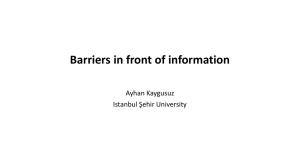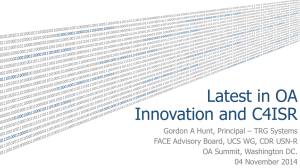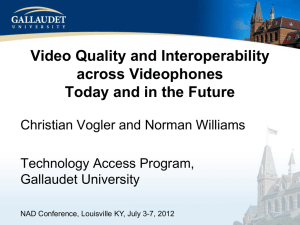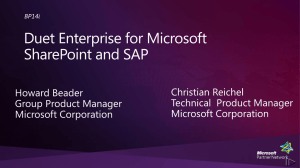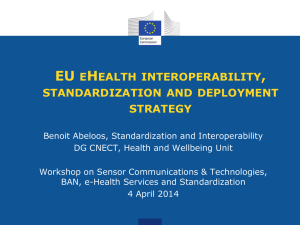Interoperability in Complex Distributed Systems
advertisement
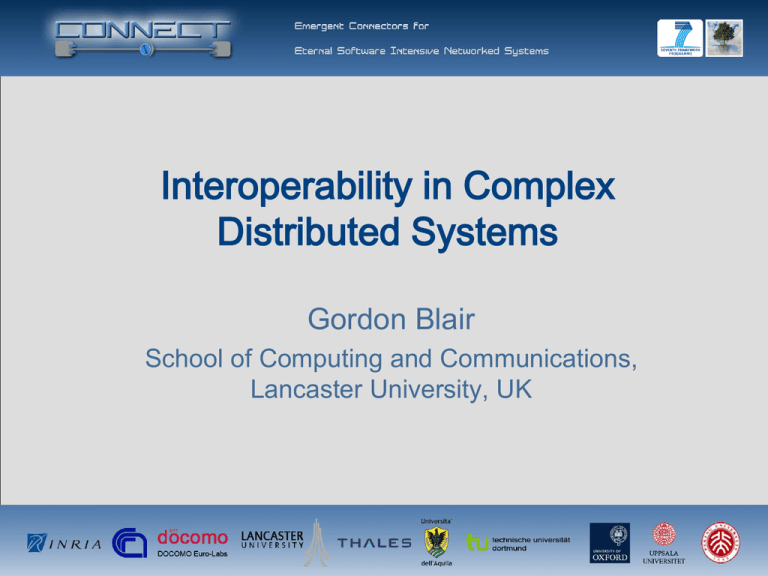
Interoperability in Complex Distributed Systems Gordon Blair School of Computing and Communications, Lancaster University, UK Outline of the Presentation Problem analysis • Trends in distributed systems • Extreme heterogeneity Focus on interoperability • What is interoperability? • Five interoperability challenges Approaches to interoperability • A state-of-the-art analysis • Towards emergent middleware The role of ontologies (Massimo’s part) • Ontologies and the semantic web • Role in emergent middleware 2 Part 1 PROBLEM ANALYSIS 3 A Few Words from Danny Cohen In the beginning ARPA created ARPANET. And the ARPANET was without form and void. And darkness was upon the deep. And the spirit of ARPA moved upon the face of the network and ARPA said, 'Let there be a protocol,' and there was a protocol. And ARPA saw that it was good. And ARPA said, 'Let there be more protocols,' and it was so. And ARPA saw that it was good. And ARPA said, 'Let there be more networks,' and it was so. Gordon’s Distributed Systems Version In the beginning there was small scale experimentation. And the experiments were without abstraction or openness. And darkness was upon the deep. And the spirit of the OMG moved upon the face of distributed systems and said, 'Let there be a middleware standard,' and there was a standard. And OMG saw that it was good. And Microsoft said, 'Let there be more standards,' and it was so. And Microsoft saw that it was good. And the community said, 'Let there be more networks and of course also mobility, ubiquity and cloud computing for good measure,' and it was so..... …. but is it good? Early distributed systems • Limited in scale and heterogeneity, issues such as openness, and support for QoS not a big issue Internet-scale distributed systems • Large scale and significant levels of heterogeneity (platforms, languages and middleware), significant advances in supporting openness and QoS The complex distributed systems of tomorrow • Significant increases in scale and also heterogeneity in all its dimensions (cf. systems of systems); more dynamic; major research questions concerning openness and QoS Illustrating the challenge: Towards environmental observatories Motivation • Many well-known challenges to the environment • Global warming, pollution, diminishing of natural resources, threats to bio-diversity, etc. • The environment decade [Al Gore, Earth in the Balance] • Book also focuses on the potential role of technology in addressing these problems What is an environmental observatory? • Investigating the role of contemporary computing technologies, particularly where pervasive technologies meet distributed systems in supporting the (real-time) monitoring and management of the natural environment Part 2 A CLOSER LOOK AT INTEROPERABILITY 9 Focus on Interoperability Interoperability “the extent by which two implementations of systems from different manufacturers can coexist and work together by merely relying on each other’s services as specified by a common standard”. Interoperability Challenges Five challenges that must be resolved to achieve interoperability: 1. 2. 3. 4. 5. 11 Discovery protocol interoperability * Interaction protocol interoperability * Data interoperability * Application interoperability * Interoperability of non-functional properties Illustrating Interoperability Challenges Who has? I offer! Need 5! Will be 9€ Client / Server € SOAP Peer-2-Peer UPnP £ Illustrating Interoperability Challenges No. Country Platform Middleware Application Data/ Currency 1 Germany Java Tuple Space GetInfo EUR 2 Great Britain Microsoft SLP+SOAP GetInfo GBP 3 France Java SSDP+SOAP GetInfo EUR 4 Italy Java SSDP+SOAP GetLocation EUR + GetPrice+ GetQuantity 5 Switzerland Java SSDP+SOAP GetInfo CHF 6 Spain Java SLP+SOAP GetInfo EUR Use different middleware = cannot interoperate Call different application operations = cannot interoperate Exchange different data = cannot interoperate 1. Discovery Protocol Interoperability 2. Middleware Protocol Interoperability CORBA Service (IIOP) Web Service (SOAP) 3. Data Interoperability <price> <price> <value> 1 </value> <value> 1 </value> <currency> euro </currency> <currency> pound</currency> </price> </price> <price> <value> 1 </value> price(1,euro) <currency> euro </currency> </price> <price> <cost> <value> 1 </value> <amount> 1 </ amount > <currency> euro </currency> <denomination> €</ denomination > </price> </cost> 4. Application Interoperability CORBA Client Calls: • GetInformation(Merchant) Name, Product, Price CORBA Server Interface • GetName()Name • GetProduct()Product • GetPrice()Price Client cannot interoperate with this service (even when the protocols and data match) • Cannot easily standardise application interfaces Part 3 EXISTING APPROACHES TO INTEROPERABILITY 18 Approaches to Interoperability 1. One speaker talks the other’s language 2. Auxiliary Languages (e.g. Esperanto) 4. A chosen shared language 3. One 3rd party translator e.g. English to French translator 5. Babel fish Standards-based Approaches Application Middleware Middleware Peer Application Peer CORBA, Web Services • Everyone has to be aware of the same standard • No interoperation with alternative standards and protocols • New standard comes along ... • Another interoperability problem 4. A chosen shared language Bridging Legacy Application Legacy Middleware A Peer Bridge A to B 3rd Party Peer (Infrastructure) Legacy Middleware B Legacy Application Peer E.g. SOAP2CORBA Bridge must be deployed Significant development effort • For every protocol pair • New protocol • Equals a bridge to every existing protocol 3. One 3rd party translator e.g. English to French translator Transparent Interoperability Legacy Application Legacy Middleware Peer Translation to Intermediary Translation from Intermediary Legacy Middleware 3rd Party Peer (Infrastructure) Legacy Application Peer Enterprise Service Buses (ESB), INDISS Mapping to a common protocol • Translation at either end – to/from the legacy or local protocol Greatest common divisor problem • Only have the subset of behaviour that matches between a pair 2. Auxiliary Languages (e.g. Esperanto) Interoperability Substitution Platforms Interoperability Platform Application Translatio n Substituted Middleware Peer Legacy Middleware Legacy Application Peer UIC, ReMMoC, WSIF One peer has to know in advance it will be a translator • Knowledge of all potential protocols ... 1. One speaker talks the other’s language We Want Future-Proof Interoperability Existing approaches to interoperability do not work for distributed systems of tomorrow • Fundamental re-think required • Towards emergent middleware • Can we observe, learn synthesize and deploy a binding dynamically Interoperability Solution Monitor & Learn Monitor & Learn Synthesize CORBA service 5. Babel fish Generated BINDING Web Service Part 4 THE ROLE OF ONTOLOGIES (MASSIMO) 25 Conclusions This presentation has charted the increasing complexity of contemporary distributed systems stemming from extreme heterogeneity and dynamism This level of complexity makes it very difficult to ensure even the most basic property of distributed systems, that is interoperability Existing solutions are not sufficient to meet the demands of complex distributed systems We argue that a new approach is required: • Emergent middleware Ontologies have a key role in realising emergent middleware by providing cross-cutting capabilities capturing the meaning of concepts and supporting associated reasoning capabilities 26
